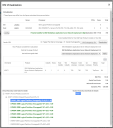Data Summary page: Software Installs tab
The Software Installs tab on the Data Summary page contains all software installs across all OSIs. This is particularly useful for seeing the relationship between host OSIs and their associated child OSIs, and for providing access to the OSI Virtualisation dialog. You can navigate, sort, and filter the data grid, and also export data from it using the data export options in the ![]() menu for each column. For more information on data grids, see Viewing pages of data.
menu for each column. For more information on data grids, see Viewing pages of data.
Click  to the left of an entry to display its Detail expansion pane and see the software details for the selected product. You can also drill-down further by clicking the
to the left of an entry to display its Detail expansion pane and see the software details for the selected product. You can also drill-down further by clicking the  icons to the left of each of the subsequent expansion panes.
icons to the left of each of the subsequent expansion panes.
OSI Virtualization dialog
Click the link in either the OSI column or the Host column for the software install you want to view.
The OSI Virtualization dialog, which has two panes, appears.
Virtualization pane
The Virtualization pane provides the following information relating to the calculation of the liability for the selected software install:
•The server type, processor details, physical CPUs and cores of the physical host, and the partition type and virtual processors for the OSI appear at the top of the pane.
•Below this, the Calculated Liability section displays the potential liability calculated for the product.
•Below this, the Virtualization pane states the total number of OSIs for the selected host that have product installs, and the total number of software installs on the host.
•The Full/Sub Capacity section enables you to calculate liability for the selected example based on sub-capacity or full capacity as required. In this example, the reconciliation was run with IBM sub-capacity licensing enabled, so the potential liability initially shown in the Calculated Liability section on opening the OSI Virtualization dialog was based on the sub-capacity licensing being enabled. This is also confirmed by the Sub-Capacity button, which states VM Subcapacity On.
To calculate the liability for the selected host using full capacity licensing:
1.Click the Sub-Capacity button to toggle through the sub-capacity settings until VM Subcapacity Off appears.
2.Click Recalculate.
License Optimizer refreshes the Calculated Liability section to display the potential liability based on the selected sub-capacity setting.
The recalculation functionality is provided for information only and does not affect the underlying reconciliation record. To run a reconciliation based on different sub-capacity settings, you need to run a new reconciliation. For more information, see Start Reconciliation.
•The final section provides information relating to the root product considered in the calculation, and the identified optimal coverage product (in this example, they are the same). The derived downgrade path is detailed (and in some cases, you may select and apply alternative paths to determine what the outcome might be based on a different path being used).
A table of information about the liability calculation appears, and a list of calculated vendor PVU values and Core Factor values appear for the selected host.
Hierarchy pane
The Hierarchy pane displays the Virtual Hierarchy section and the Cluster Hierarchy section:
•The Virtual Hierarchy section shows the relationship between the host and any partitions associated with it. It also provides information relating to:
•The physical CPUs and cores of the physical host
•The virtual processor and entitled capacity settings for the pools and partitions associated with the host
•The OSIs that contain installs of the selected software product (these are highlighted in bold, green text)
•The Cluster Hierarchy section shows relationships relating to clustered OSIs. (The above example does not have cluster relationships, so the Cluster Hierarchy lists only the host OSI.)




